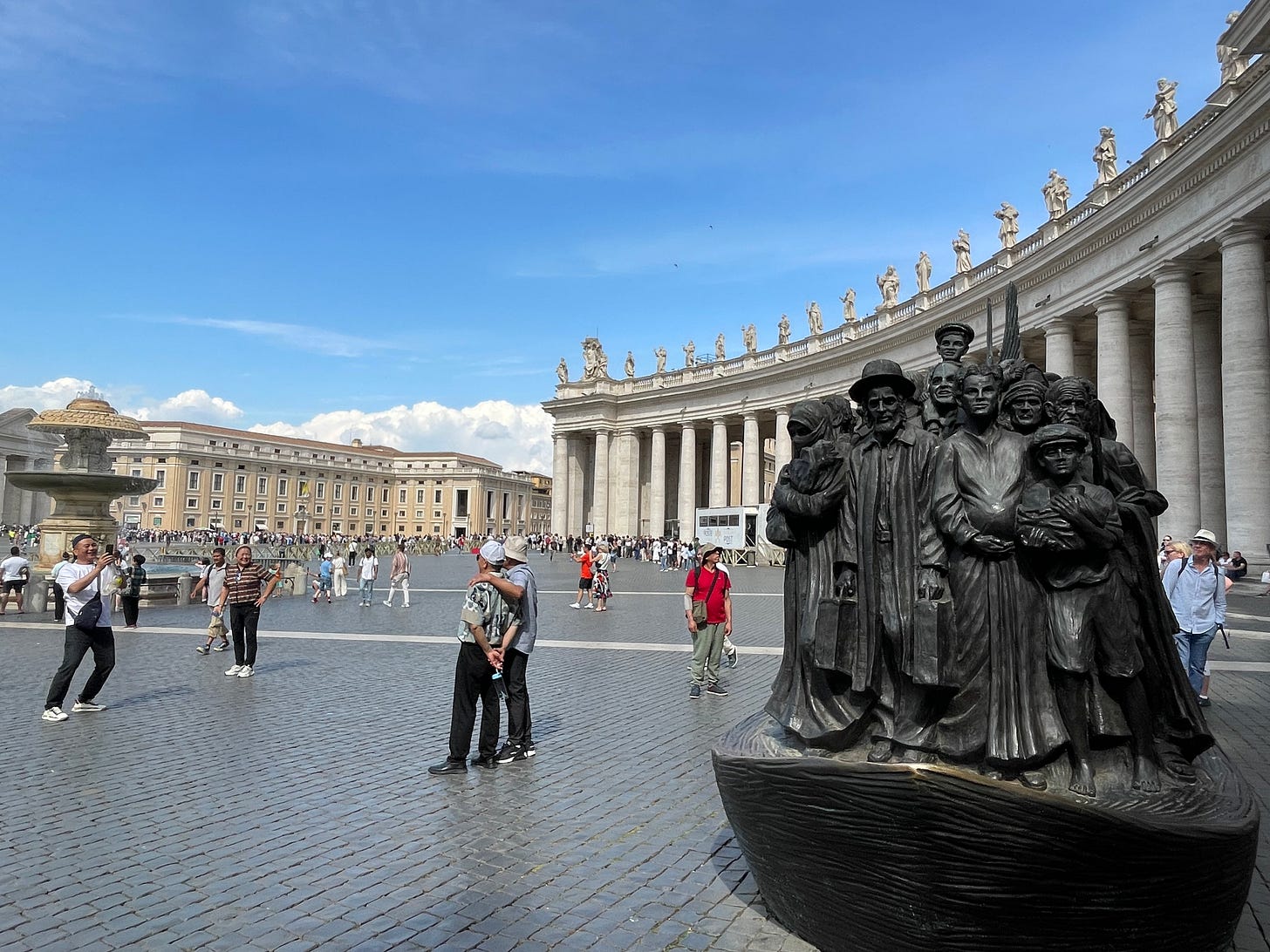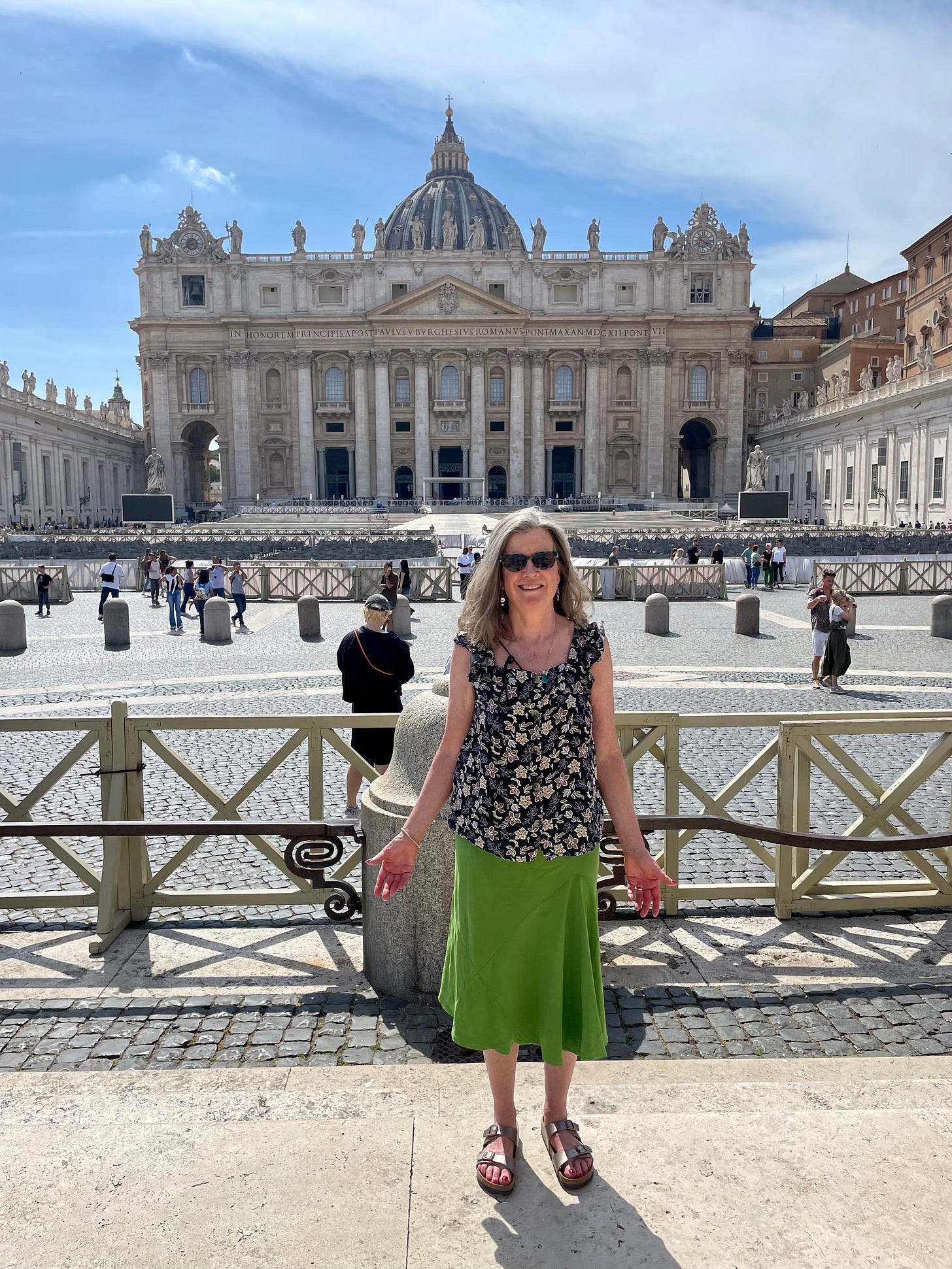Pondering the Pope
along with values, culture and Conclave
Pope Francis fittingly passed on Easter Monday, the commemoration of when Jesus Christ proved the soul lives on after death to believers. The humble leader of the Catholic Church of the past dozen years was also a card carrying member of a Buenos Aires soccer club. The numbers on his card, 88, 2, 3, 5 matched his age and the time in his home country of Argentina when he died. Divine synchronicities? I think so.
Easter Sunday an ailing Papa Francesco managed a “Buona Pasqua” from his balcony to the crowd filling St. Peter’s square, really an elliptical piazza, envisioned by designer Gian Lorenzo Bernini as the “maternal arms of the Mother Church.” The colonnade lined with statued saints, Michelangelo’s masterpiece dome visible from all over Roma. Six days later, at least a quarter of a million mourners witnessed the pope’s funeral, angelic clouds on a clear blue sky over the eternal city. Now the centuries young process of electing a new leader of the Catholic Church and a global moral authority is almost underway.
Known as il papa del popolo, or the people’s pope, Francis truly embodied the teachings of Jesus-to give a hoot about our fellow humans having the hardest time. To champion the underdog, the underserved, the underrepresented. These were the values instilled in my siblings and I by our late mother, Bobbie, raised in an Irish Catholic family and community in Evanston, a suburb of Chicago on the North Shore of Lake Michigan.
Jorge Mario Bergoglio took his name for St. Francis of Assisi, the patron saint of all living things, the birds to the trees to the people, especially those who struggle to put food on the table, let alone own one.
“Whatsoever you do, to the least of my brothers, as you do unto me.” The hymnal words still ring in my head, oft-quoted by mom as she emptied the dishwasher for the umpteenth time (as she put it). “It’s not about you, “ she’d affirm, “It’s about people who have less than you.”
On a humid day in May 2024, my husband Karl and I wandered St. Peter’s Square, shocked by the weary line of tourists lining the periphery, holding tickets and waiting hours for entrance to the Basilica. When in Rome in 1996 for my parents 35th anniversary, we’d just walked on in. In 1984, me and Kim, a fellow American hostel-mate, attended a Holy Saturday midnight mass at St. Peter’s on a beautiful Easter weekend. Kim fell asleep. But I was thrilled to be back at this de-facto wonder of the world.
In 1962, I was born in Rome to American parents and baptized at St. Peter’s, followed by my brother John in 1963, baptized at St. John Lateran the Pope’s other home in his dual role as the Bishop of Rome. At 62, I thought another visit was in order.
I wonder what it meant to my mother, to have her first child baptized at ground zero for the Catholic Church. Bobbie attended Catholic schools through university at St. Mary’s of the Woods in Indiana, the women’s sister college to Notre Dame. At one point in her childhood, she considered becoming a nun. “I just loved the nuns,” she’d say, a wistful look in her eye. Instead, motherhood became her vocation (before a career in real estate). John and I gained another four siblings after our family returned to the U.S. in the fall of 1963.
At 10 I wrote a letter to Father Dingberg asking why there were altar boys but no altar girls. In 8th grade I became a confirmed Catholic, along with my classmate and friend Jeannie Sullivan. In my late teens, I quit going to church, along with my siblings. My list of grievances included the exclusion of women from the priesthood and the medieval stance on abortion. My mother accepted my decision but stayed with the church, bringing communion to elderly people unable to leave their homes. At Jeannie’s wedding in a campus candle-lit chapel infused with incense and adorned with painted angels, I realized that despite my turn away from it, the church was the closest thing I had to a cultural identity.
Pope John Paul wished the masses a Buona Pasqua that Easter mass forty-one years ago. He was the first non-Italian pontiff in 455 years. Like John Paul and his predecessor Benedict, Francis was not Italian, but he was the son of Italian immigrants to Argentina.
Papa Francesco saw immigrants as his brothers and sisters. Up until his passing, the two global leaders most focused on immigration were Pope Francis and President Trump. As Trump throws away the constitutional right of due process and exiles immigrants with no criminal records to a notorious prison in El Salvador, Francis is remembered for imploring the U.S. to “build bridges, not walls.”
Relatively new on St. Peter’s square is a bronze sculpture depicting immigrants from the world over the course history, packed tightly on a boat. “Angels Unawares” was unveiled by Pope Francis in September 2019 on World Refugee Day. The 3.5 ton, 20-foot high work of art, “recalls the extreme scarcity that refugees have had to endure, while simultaneously serving as a piercing reminder that it is the very victims of famine, disease, war and heartbreak — people whom the pope called "the poorest of the poor—”
Dating back 2000 years, popes have been around a lot longer than presidents. Of course the values of the now passed Pope and the current POTUS could not be more opposite. Here’s a few headings published in an Apostolic Exhortation in the first year of Francis’ papacy, three years before the first Trump administration:
No to an economy of exclusion
No to the new idolatry of money
No to a financial system which rules rather than serves
No to the inequality which spawns violence
As depicted in the film The Two Popes (2019), Francis had direct experience with the evils of authoritarianism. Some of his Jesuit colleagues were killed, disappeared and tortured under Argentina’s corrupt and violent authoritarian regime (1976-83).
“A new tyranny is thus born, invisible and often virtual,” he wrote, “which unilaterally and relentlessly imposes its own laws and rules.” Money must serve, not rule! A corrupt society stinks! These words of the late Pope speak to the series of horrors unfolded in the first 100 days of the Trump administration.
And while Trump favors garish gold when it comes to interior design, Francis chose to live in a simple guest house over the lavish Apostolic Palace.
Francis last word was his coffin, of zinc-lined cypress and bearing no gold trim or papal crest, just a simple cross. Mourners lined the streets between the Vatican and Francis’ final resting place for a glimpse of the box placed in a white flat-bed truck aka Pope-Mobile.
“Never tell another person you hate them,” warned my mother, “If you hate someone, it means you wish they were dead.” Francis’ explanation was a little more nuanced. “To insult or hate someone, or to have contempt, is a way of "killing the dignity of a person. Human life needs love."
Lack of love for human life is the root of war and a myriad of human suffering. Just hours before his death, Pope Francis called for a ceasefire in Gaza, where more than 65,000 people, seventy percent of them women and children, have been killed since October 7, 2023, when Hamas terrorists slaughtered about 1200 people in Israel and took more than 250 hostages.
On the third anniversary of the unprovoked war against Ukraine by Russia in February, Pope Francis expressed a renewed, “solidarity with the martyred Ukrainian people," and invited the world “to remember the victims of all armed conflicts and to pray for the gift of peace in Palestine, Israel, and throughout the Middle East, in Myanmar, in Kivu, and in Sudan."
The image of the presidents of the United States and Ukraine sitting face to face and deep in conversation in a centerpiece of human history as they awaited the pontiff’s funeral brings a glimmer of hope to the prospect for resolution.
I was in my early thirties by the time Pope John Paul allowed altar girls. There was hope for the ordination of women priests by Francis. But no go. How he dealt with the ongoing sexual abuse crisis got mixed reviews. He approved the blessing of same sex couples but stopped short of fully addressing LBGTQ+issues. He spoke out on the ravages of climate change to marginalized people and Mother Earth.
The Catholic Church remains as gender imbalanced as the rest of the world when it comes to leadership. My mother called Italian men “peacocks” strutting about in tailored suits and smart haircuts, while their mothers and wives served them hand and foot.
Karl and I were part of the recent three-hundred percent increase in viewing of the 2024 film Conclave, said to accurately portray how a new Pope is selected from a slew of peacocks (Cardinals actually) in red brocaded cassocks and little hot pink hats, (aka zuchettos), secluded in the Sistine Chapel.
The inequality of the church is shown by the nuns in the film, wearing drab dresses and modest habits, doing little else than cook for the College of Cardinals (with the exception of the Isabella Rossellini character, who played a manager). But the Oscar winning (Best Adapted Screenplay) offering ends with an unexpected twist and a powerful statement.
Eighty percent of the Cardinals voting for the next Pope were appointed by Francis, many of them from diverse backgrounds and developing countries. If the new pontiff sustains the views and values of his predecessor, maybe some semblance of balance can be restored to our troubled nation and world.
The real conclave starts May 7, also the deadline to get a Real ID, and it just so happens, my birthday.





Thank you for this, Katie. It is well written and very informative.
Beautiful Thoughtful well researched piece! Loved learning new insights on the People’s Pope & the context of current world events. The Golden rules on how to treat people shared by Mom are needed more than ever right now. Thank you for sharing her light & yours with us!💖💫